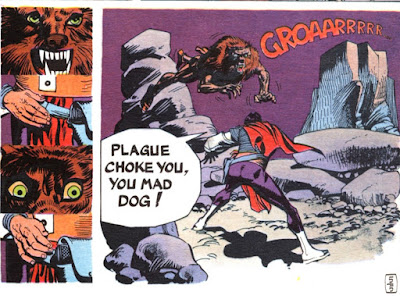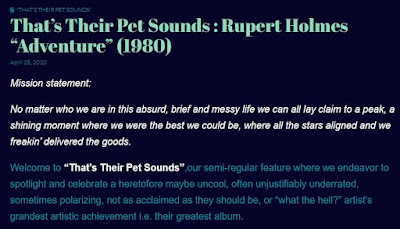Monday, May 31, 2021
An Ultimate Alchemist
Saturday, May 29, 2021
Thursday, May 27, 2021
Book Review: Warlord's World
Saturday, May 22, 2021
Adventure and the Yacht Rock sound
Adventure by Rupert Holmes and the 'Yacht Rock' Sound
With the approach of Memorial Day, Sirius XM has revived its Yacht Rock channel, returning a soothing brand of 70s and 80s sound to the ears of its listening subscribers.
Among the more prominent artists on the Yacht Rock channel is Rupert Holmes (the stage name of singer-songwriter, producer, and playwright David Goldstein, b. 1947).
In 1980 Holmes released his sixth album, Adventure, the lead single of which was 'I Don't Need You'.
'I Don't Need You', which can be listened to here, entered the Billboard Hot 100 at slot 84 in the week of April 4 1981, and peaked at slot 56. It's a great example of Yacht Rock: well-crafted, well-produced, and made in the era well before Auto-Tune and Karl 'Max Martin' Sandberg transformed songwriting and producing into exercises in digital wizardry.
Here's a link to an interesting essay at the 'Picking Up Rocks' blog on the birth and development of the songs that typify Yacht Rock radio, with an in-depth review of Adventure.
The reviewer concludes:
........it is a truly seminal Yacht Rock-West Coast-Adult Contemporary-Soft Rock-Pop classic that deserves it’s due because, let’s get “1980” for a second, it’s just totally bitchin’.
You can't beat that sort of endorsement to kick off Yacht Rock season !
Wednesday, May 19, 2021
Book Review: Heatseeker
Sunday, May 16, 2021
Prez, DC Comics, 2016
'Prez: Smells Like Teen President', from Vertigo Visions No. 1 (September 1995) is written by Ed Brubaker and illustrated by Eric Shanower, one of the most acclaimed comic book writer / artist teams of the past 30 years. Brubaker gives the Prez mythology a postmodern 90s spin; the protagonist is a disaffected Grunge rock teen named 'P.J.' who may or may not be the illegitimate son of Prez.
Friday, May 14, 2021
Three more from 2000 AD
Tuesday, May 11, 2021
Final Warning from Marvel Preview
by Lynn Graeme (story) and Frank Miller (art)
from Marvel Preview: Bizarre Adventures 2 (1980)
Even by my forgiving standards, the Fall, 1980 issue (No. 24) of Marvel Preview is pretty awful. The cover art, by Clyde Caldwell, is pure cheese, and the contents of the issue are even more trite and banal.
Saturday, May 8, 2021
Book Review: Spell of the Witch World
Wednesday, May 5, 2021
Thorgal: Almost Paradise
'Almost Paradise'
The Donning Company, 1987

























































.jpg)























